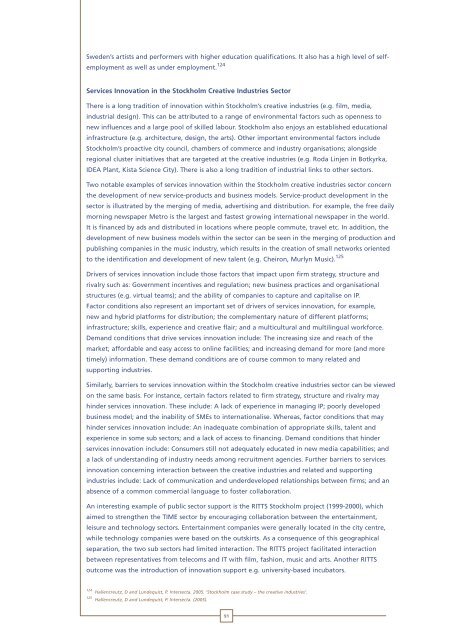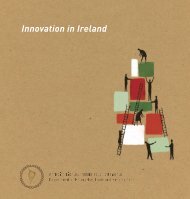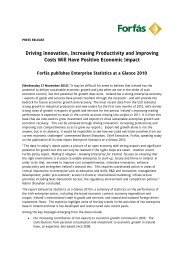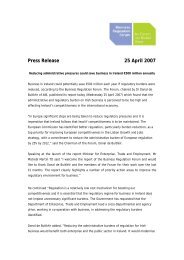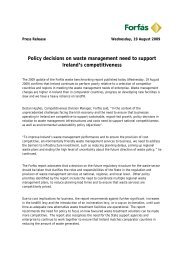Services Innovation in Ireland - Options for ... - Europe INNOVA
Services Innovation in Ireland - Options for ... - Europe INNOVA
Services Innovation in Ireland - Options for ... - Europe INNOVA
You also want an ePaper? Increase the reach of your titles
YUMPU automatically turns print PDFs into web optimized ePapers that Google loves.
Sweden’s artists and per<strong>for</strong>mers with higher education qualifications. It also has a high level of selfemployment<br />
as well as under employment. 124<br />
<strong>Services</strong> <strong>Innovation</strong> <strong>in</strong> the Stockholm Creative Industries Sector<br />
There is a long tradition of <strong>in</strong>novation with<strong>in</strong> Stockholm’s creative <strong>in</strong>dustries (e.g. film, media,<br />
<strong>in</strong>dustrial design). This can be attributed to a range of environmental factors such as openness to<br />
new <strong>in</strong>fluences and a large pool of skilled labour. Stockholm also enjoys an established educational<br />
<strong>in</strong>frastructure (e.g. architecture, design, the arts). Other important environmental factors <strong>in</strong>clude<br />
Stockholm’s proactive city council, chambers of commerce and <strong>in</strong>dustry organisations; alongside<br />
regional cluster <strong>in</strong>itiatives that are targeted at the creative <strong>in</strong>dustries (e.g. Roda L<strong>in</strong>jen <strong>in</strong> Botkyrka,<br />
IDEA Plant, Kista Science City). There is also a long tradition of <strong>in</strong>dustrial l<strong>in</strong>ks to other sectors.<br />
Two notable examples of services <strong>in</strong>novation with<strong>in</strong> the Stockholm creative <strong>in</strong>dustries sector concern<br />
the development of new service-products and bus<strong>in</strong>ess models. Service-product development <strong>in</strong> the<br />
sector is illustrated by the merg<strong>in</strong>g of media, advertis<strong>in</strong>g and distribution. For example, the free daily<br />
morn<strong>in</strong>g newspaper Metro is the largest and fastest grow<strong>in</strong>g <strong>in</strong>ternational newspaper <strong>in</strong> the world.<br />
It is f<strong>in</strong>anced by ads and distributed <strong>in</strong> locations where people commute, travel etc. In addition, the<br />
development of new bus<strong>in</strong>ess models with<strong>in</strong> the sector can be seen <strong>in</strong> the merg<strong>in</strong>g of production and<br />
publish<strong>in</strong>g companies <strong>in</strong> the music <strong>in</strong>dustry, which results <strong>in</strong> the creation of small networks oriented<br />
to the identification and development of new talent (e.g. Cheiron, Murlyn Music). 125<br />
Drivers of services <strong>in</strong>novation <strong>in</strong>clude those factors that impact upon firm strategy, structure and<br />
rivalry such as: Government <strong>in</strong>centives and regulation; new bus<strong>in</strong>ess practices and organisational<br />
structures (e.g. virtual teams); and the ability of companies to capture and capitalise on IP.<br />
Factor conditions also represent an important set of drivers of services <strong>in</strong>novation, <strong>for</strong> example,<br />
new and hybrid plat<strong>for</strong>ms <strong>for</strong> distribution; the complementary nature of different plat<strong>for</strong>ms;<br />
<strong>in</strong>frastructure; skills, experience and creative flair; and a multicultural and multil<strong>in</strong>gual work<strong>for</strong>ce.<br />
Demand conditions that drive services <strong>in</strong>novation <strong>in</strong>clude: The <strong>in</strong>creas<strong>in</strong>g size and reach of the<br />
market; af<strong>for</strong>dable and easy access to onl<strong>in</strong>e facilities; and <strong>in</strong>creas<strong>in</strong>g demand <strong>for</strong> more (and more<br />
timely) <strong>in</strong><strong>for</strong>mation. These demand conditions are of course common to many related and<br />
support<strong>in</strong>g <strong>in</strong>dustries.<br />
Similarly, barriers to services <strong>in</strong>novation with<strong>in</strong> the Stockholm creative <strong>in</strong>dustries sector can be viewed<br />
on the same basis. For <strong>in</strong>stance, certa<strong>in</strong> factors related to firm strategy, structure and rivalry may<br />
h<strong>in</strong>der services <strong>in</strong>novation. These <strong>in</strong>clude: A lack of experience <strong>in</strong> manag<strong>in</strong>g IP; poorly developed<br />
bus<strong>in</strong>ess model; and the <strong>in</strong>ability of SMEs to <strong>in</strong>ternationalise. Whereas, factor conditions that may<br />
h<strong>in</strong>der services <strong>in</strong>novation <strong>in</strong>clude: An <strong>in</strong>adequate comb<strong>in</strong>ation of appropriate skills, talent and<br />
experience <strong>in</strong> some sub sectors; and a lack of access to f<strong>in</strong>anc<strong>in</strong>g. Demand conditions that h<strong>in</strong>der<br />
services <strong>in</strong>novation <strong>in</strong>clude: Consumers still not adequately educated <strong>in</strong> new media capabilities; and<br />
a lack of understand<strong>in</strong>g of <strong>in</strong>dustry needs among recruitment agencies. Further barriers to services<br />
<strong>in</strong>novation concern<strong>in</strong>g <strong>in</strong>teraction between the creative <strong>in</strong>dustries and related and support<strong>in</strong>g<br />
<strong>in</strong>dustries <strong>in</strong>clude: Lack of communication and underdeveloped relationships between firms; and an<br />
absence of a common commercial language to foster collaboration.<br />
An <strong>in</strong>terest<strong>in</strong>g example of public sector support is the RITTS Stockholm project (1999-2000), which<br />
aimed to strengthen the TIME sector by encourag<strong>in</strong>g collaboration between the enterta<strong>in</strong>ment,<br />
leisure and technology sectors. Enterta<strong>in</strong>ment companies were generally located <strong>in</strong> the city centre,<br />
while technology companies were based on the outskirts. As a consequence of this geographical<br />
separation, the two sub sectors had limited <strong>in</strong>teraction. The RITTS project facilitated <strong>in</strong>teraction<br />
between representatives from telecoms and IT with film, fashion, music and arts. Another RITTS<br />
outcome was the <strong>in</strong>troduction of <strong>in</strong>novation support e.g. university-based <strong>in</strong>cubators.<br />
124 Hallencreutz, D and Lundequist, P. Intersecta. 2005. ‘Stockholm case study – the creative <strong>in</strong>dustries’.<br />
125 Hallencreutz, D and Lundequist, P. Intersecta. (2005).<br />
91


